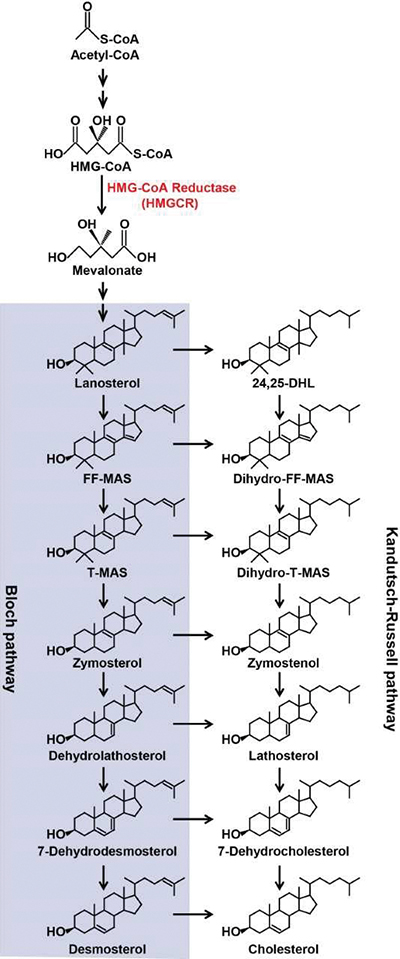JLR: What controls cholesterol biosynthesis?
Homeostasis is an important biochemical principle. The pace of a biosynthetic pathway often is controlled by feedback from pathway products, adjusting the system to prevent excessive accumulation of its products.
 A pathway diagram shows two parallel routes from mevalonate to cholesterol.Bao-Liang Song
A pathway diagram shows two parallel routes from mevalonate to cholesterol.Bao-Liang Song
Cholesterol biosynthesis is one example. Researchers know it is regulated by metabolic intermediates but until now have disagreed about which intermediates do the work. In the Journal of Lipid Research, Liang Chen and colleagues at Wuhan University and the Chinese Academy of Sciences report that several metabolites can affect the activity of two cholesterol biosynthesis enzymes. The study gives new insight into how cholesterol biosynthesis is regulated.
Researchers knew that an intermediate product of the biosynthetic pathway could inhibit each of two control points: HMG-CoA reductase, or HMGCR, which synthesizes a key cholesterol precursor called mevalonate, and sterol responsive element-binding protein, or SREBP, a transcription factor that affects many cholesterol synthesis enzymes.
Data suggested that lanosterol, the first intermediate in the pathway that is cyclic instead of linear, was the key regulator, but the researchers knew that a slightly modified version of lanosterol might be more important. The question is complicated because the cholesterol biosynthesis pathway bifurcates after lanosterol is formed.
In lanosterol or any of its downstream products, a double bond in the molecule’s alkyl tail can be reduced, and the reduced molecules proceed through the same steps to be turned into cholesterol (see figure). So which intermediate cholesterol metabolite exerts the most control over the overall biosynthetic pathway?
That is a technically difficult problem. It is hard to induce accumulation of specific intermediates, because no effective enzyme inhibitors exist for specific steps in sterol synthesis and cells are unlikely to take up exogenously added pathway intermediates.
Chen and colleagues worked around these difficulties by generating a cell line better equipped to absorb mevalonate, a key intermediate produced by HMGCR. In these cells, intermediates can accumulate even if HMGCR activity is blocked. When these cells are provided with mevalonate, they scale up cholesterol production, triggering homeostatic degradation of HMGCR and blocks SREBP activation.
The team then systematically knocked out cholesterol biosynthesis enzymes using CRISPR, forcing traffic to back up immediately upstream of whichever conversion step had been blocked. Using lipidomic analysis of sterol extracts from each knockout cell line, they assessed the impact of loss of each enzyme and accumulation of its substrate, identifying key metabolites that impacted levels of HMGCR and SREBP.
The researchers showed that lanosterol down-regulated HMGCR but not SREBP, confirming that lanosterol and not its reduced relative is the key regulator. They also found that other sterol intermediates with reduced double bonds inhibited both HMGCR and SREBP. The authors say that molecules resembling these endogenous regulators could be a new way to control cholesterol levels.
Enjoy reading ASBMB Today?
Become a member to receive the print edition four times a year and the digital edition monthly.
Learn moreGet the latest from ASBMB Today
Enter your email address, and we’ll send you a weekly email with recent articles, interviews and more.
Latest in Science
Science highlights or most popular articles

The science of staying strong
Muscles power every movement, but they also tell the story of aging itself. Scientists are uncovering how strength fades, why some species resist it and what lifestyle and molecular clues could help preserve muscle health for life.

Bacteriophage protein could make queso fresco safer
Researchers characterized the structure and function of PlyP100, a bacteriophage protein that shows promise as a food-safe antimicrobial for preventing Listeria monocytogenes growth in fresh cheeses.

Building the blueprint to block HIV
Wesley Sundquist will present his work on the HIV capsid and revolutionary drug, Lenacapavir, at the ASBMB Annual Meeting, March 7–10, in Maryland.

Gut microbes hijack cancer pathway in high-fat diets
Researchers at the Feinstein Institutes for Medical Research found that a high-fat diet increases ammonia-producing bacteria in the gut microbiome of mice, which in turn disrupts TGF-β signaling and promotes colorectal cancer.

Mapping fentanyl’s cellular footprint
Using a new imaging method, researchers at State University of New York at Buffalo traced fentanyl’s effects inside brain immune cells, revealing how the drug alters lipid droplets, pointing to new paths for addiction diagnostics.

Designing life’s building blocks with AI
Tanja Kortemme, a professor at the University of California, San Francisco, will discuss her research using computational biology to engineer proteins at the 2026 ASBMB Annual Meeting.

